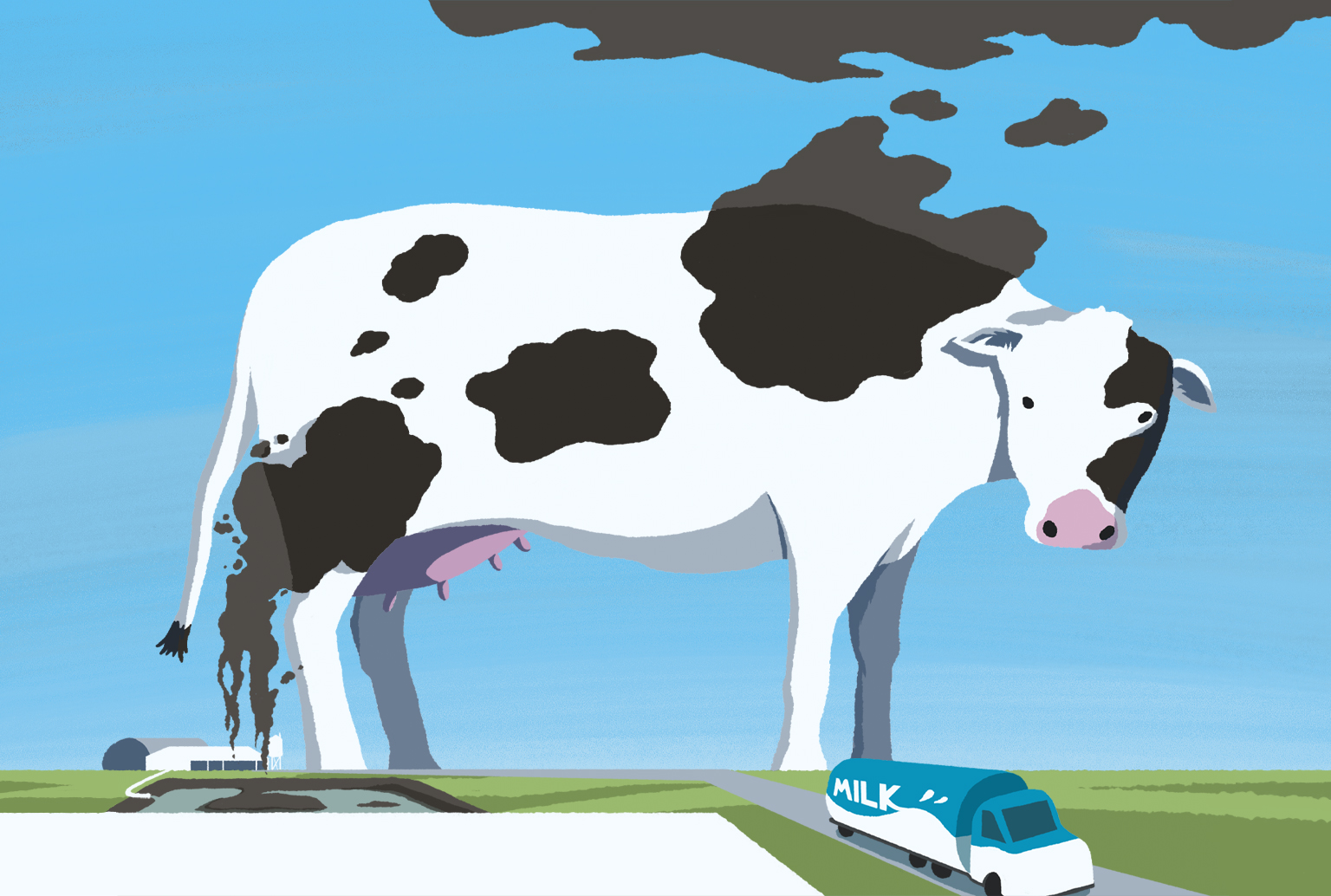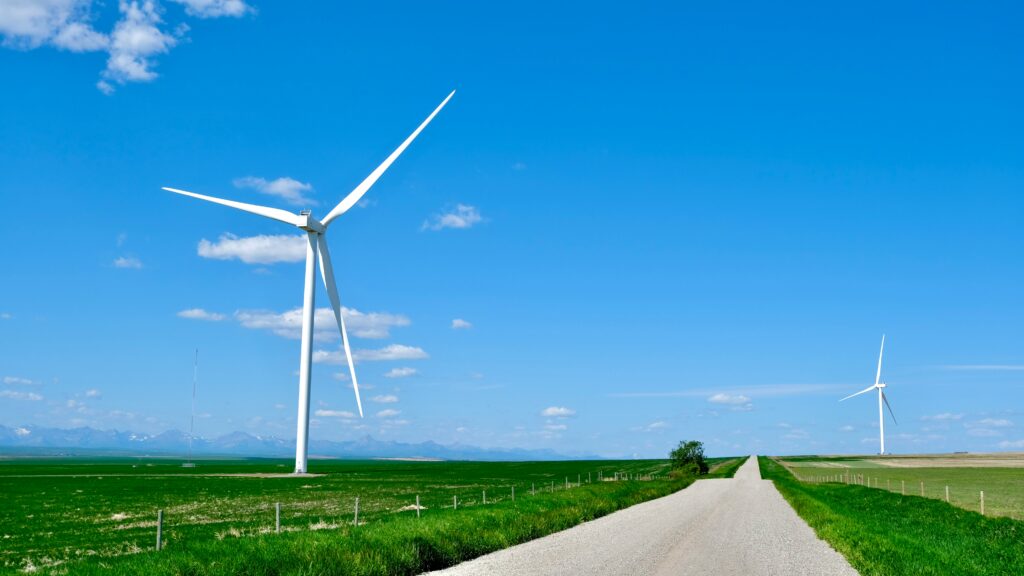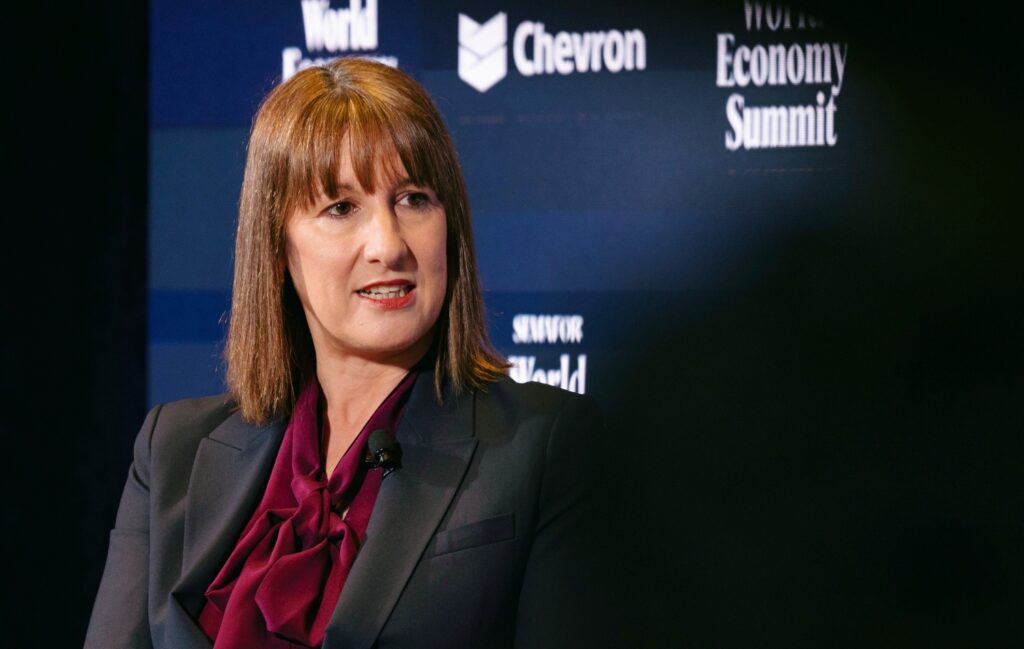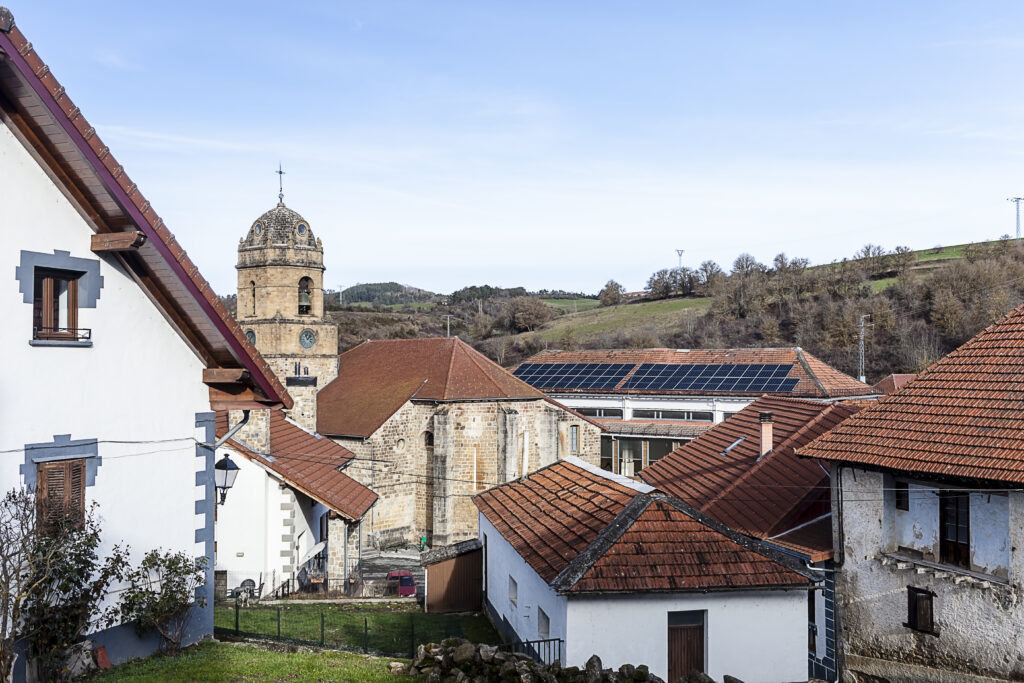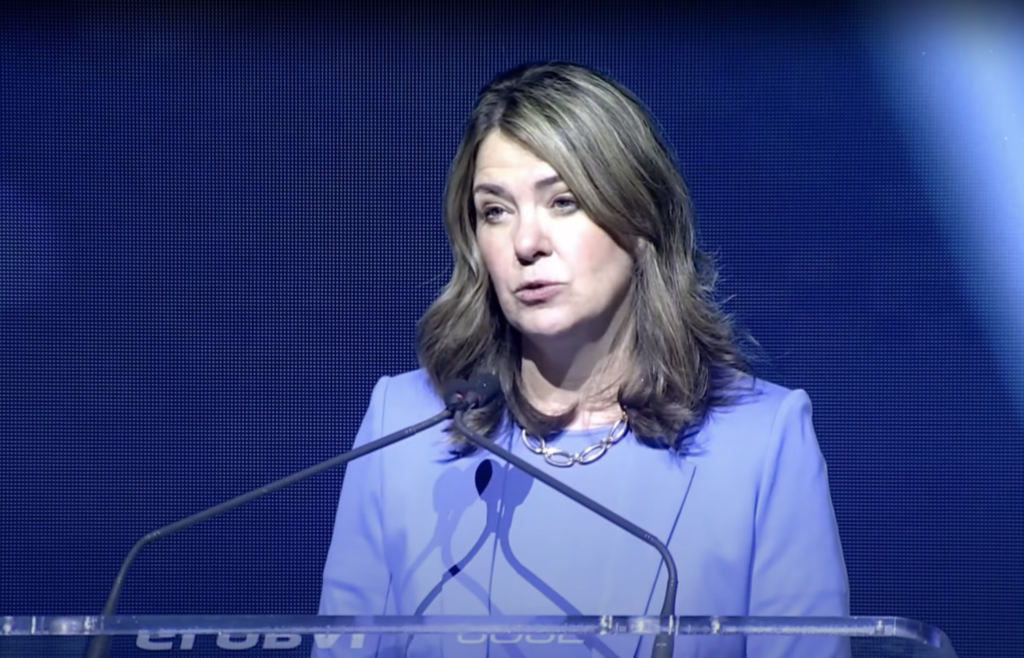When Pathways to Dairy Net Zero (P2DNZ) made its debut ahead of the United Nations Food Systems Summit in 2021, it looked like the kind of group that could meet an important but largely neglected area of global climate response.
Armed with a seat at the highest levels of food policy, and well-connected – to dairy producers, distributors, and scientists – the initiative described itself as a “growing movement” dedicated to “reducing dairy’s greenhouse gas (GHG) emissions over the next 30 years”.
A month after the food summit, P2DNZ made a splash at the COP26 climate conference in Glasgow, Scotland, where Tom Vilsack, the US Secretary of Agriculture – himself the former CEO of a major dairy industry lobbying firm – expressed his department’s “strong support”. Later this year, P2DNZ will also be making an appearance at COP28 in Dubai.
Dairy is a serious, but under-discussed source of planet-warming gases. Cows produce methane, a greenhouse gas that absorbs more atmospheric heat than carbon and is currently responsible for 25 percent of all global warming today. But its problems go well beyond the farm.
In 2015 the emissions generated along the entire dairy production chain – from cow to grocery store shelf – accounted for an estimated 3.4 percent of all human-induced greenhouse gas emissions. That’s a larger share of global emissions than aviation.
The dairy industry’s emissions are also growing fast. From 2005 to 2015, dairy’s gaseous output increased by 18 percent. And while the highest levels of milk consumption per person are still concentrated in the Global North, most of the recent increase has occurred in low and middle-income countries where rising affluence has led to greater demand for dairy.
Over the past two years, P2DNZ has positioned itself as the vanguard of a global response to its sector’s rising emissions at summits and high-level meetings around the world. But who is in this group and what do the various organizations backing it really want?
Getting Past The Rhetoric
The impetus for Pathways to Dairy Net Zero began with a report published in 2019 by the United Nations’ Food and Agriculture (FAO) and the Global Dairy Platform (GDP), an industry group that collects and disseminates dairy-related science.
Despite a climate-centric title (“The role of the dairy sector in a low-carbon future”), the paper described global heating as just one of several problems, along with poverty and food security, where the dairy industry had an important role to play. Addressing all of them, the paper said, necessitated “win-win solutions” that could leverage the dairy industry’s power without compromising it.
P2DNZ has maintained this pro-industry stance in presentations. It keeps the focus broad, promoting itself as a leader on climate change while simultaneously downplaying global warming’s significance vis-a-vis other issues and espousing solutions that can serve the industry.
“It’s important that we recognize dairy is not just about emissions,” Donald Moore, GDP’s executive director and the public face of P2DNZ, said during a presentation at the UN High-Level Political Forum on Sustainable Development last July. “When we start to tackle an issue like emissions reductions, we need to be careful that we don“t create a bigger problem in food nutrition [and] security, livelihoods, and economic growth […]”
Such rhetoric may come as little surprise considering its supporters. P2DNZ is a collaboration between GDP and five other international groups connected to the dairy industry. They include the Sustainable Agriculture Initiative (SAI) Platform (a club for food companies including Nestlé, PepsiCo and Unilever) and the International Dairy Federation (IDF, a group of dairy farmers’ organisations) along with public research bodies and the FAO.
As Moore has said at various public appearances, anyone can become a P2DNZ supporter. But Global North groups dominate. Out of more than 200 groups currently listed on its website, 51 are from the United States and Canada, compared to only 11 from Africa.
P2DNZ’s supporters are also overwhelmingly affiliated with industrial-scale dairy. A large majority are large, for-profit food corporations – including Starbucks and Coca Cola (which took full control of a milk brand, Fairlife, in 2020). Eight of the ten largest dairy companies in the world – along with trade groups, and dairy farmer organisations – are also among P2DNZ’s listed supporters.
These groups not only produce the most milk, they are among the largest sources of greenhouse gas emissions in the world. According to an analysis by the Institute for Agriculture and Trade Policy (IATP), in 2021, P2DNZ member and “methane giant”, the Dairy Farmers of America, the largest dairy producer in the United States, emits the equivalent of the UK’s entire livestock sector. Fonterra, the largest dairy co-op in New Zealand, accounts for an emissions output only slightly less than Ireland’s livestock sector.
Livestock methane emissions are also rising in some of these countries. In the United States, for instance, livestock methane emissions have increased by around five percent since 2010, according to the IATP report, and by around 20 percent since 1990, even as overall methane emissions have declined.
(Following its publication, Fonterra told DairyReporter the IATP’s report contained “several inaccuracies” and that it over-reported its GHG contribution. Dairy Farmers of America referred to a joint statement from IDF and GDP, which said the report had overstated dairy’s overall GHG contribution.)
Any organisation can become a P2DNZ “supporter” by endorsing a five-point declaration on fighting emissions. Importantly, this does not require its highly polluting supporters to cut greenhouse gas emissions – or even to have a plan for doing so. While the declaration mentions the need to “reduce methane emissions”, alongside positivist statements about the dairy industry, any reference to the need for absolute, rapid cuts in emissions – which climate scientists are urgently calling for – is noticeably absent.
The Efficiency Game
Instead, the heart of P2DNZ’s emissions-reducing agenda comes down to one word: efficiency.
For the dairy industry, “Improving efficiency” – which according to point three of P2DNZ’s declaration offers a way to “reduce emissions” and “improve productivity” – means using fewer resources, like feed for cows. It also means emitting less greenhouse gas per unit of milk, or reducing the greenhouse gas “intensity” of milk production.
The two kinds of efficiency are closely related, as methane, dairy’s primary greenhouse gas, is a byproduct of the bovine digestive process which makes milk in the first place. In other words, more milk equals more methane. Meanwhile, the more feed a cow eats, the more milk and more emissions it tends to produce, so improving the ratio of milk to gas reduces the environmental burden of a single unit of milk.
But there“s a problem with this line of thinking. Ramping up efficiency doesn’t mean less greenhouse gas in the atmosphere, only more milk per unit of gas. As the 2019 FAO and GDP report found, in the decade that dairy-related greenhouse gas emissions increased by 18 percent, dairy production had increased by 30 percent, “in response to increased consumer demand”.
The dairy industry, in other words, is learning to do more with less. But instead of reducing its pollution, improving efficiency has only enabled it to produce more milk – and with it, more emissions.
“The climate does not care about efficiency – it requires absolute emissions reduction. Decreasing emissions per litre or gallon of milk while ever increasing the total amount of milk produced is not going to get us there.”
– Shefali Sharma, director of the Institute for Agriculture and Trade Policy (IATP) European office
In fact, a closer look at P2DNZ shows that environmental considerations take a backseat to what appears to be the initiative’s primary ambition, which is to intensify and increase dairy production. As Vilsack said at the COP26 climate summit: “to successfully feed a growing world population… we need to scale up sustainable production”.
GDP, which handles media relations for P2DNZ, did not respond to requests for comment.
Shefali Sharma, the director of the European office of IATP, says equating efficiency with climate progress is a mistake. “The climate does not care about efficiency – it requires absolute emissions reductions,” she says. “Decreasing emissions per litre or gallon of milk while ever increasing the total amount of milk produced is not going to get us there. So, the dairy industry needs to dramatically rethink its model of production and growth.”
Writing Efficiency Into Policy
P2DNZ might be yet one more corporate greenwashing effort had it not worked its way into some of the most influential fora of global climate policy. One of its flagship initiatives features as an “innovation sprint” – a capital-intensive project focused on a particular climate goal – which is being championed through AIM for Climate (AIM4C), the US-United Arab Emirates climate partnership that will be active at COP28. One of 51 “sprints”, the project (which predates AIM4C) puts P2DNZ in a leading position to shape climate plans in middle-income “emerging dairy countries”.
Nine nations (including Kenya, Colombia, and Pakistan) have already signed agreements with P2DNZ that allow the initiative and its partners to advise those countries as they write applications for support from the Green Climate Fund (GCF), a multilateral entity that helps Global South countries finance climate adaptations. As of last autumn, India was discussing representation with the initiative. These ten countries together account for about 30 percent of global dairy-related emissions.
“Frankly, this is quite concerning,” Sharma told DeSmog. “These companies literally earn billions in revenue each year – they could support their suppliers in Africa and elsewhere directly, rather than depending on public funds to help them intensify livestock production in places like Kenya and elsewhere.”
P2DNZ’s involvement with the climate fund has already yielded results: during the COP27 meeting in Sharm-el-Sheikh, Egypt, GCF pledged millions to speed up the adoption of new climate-friendly and productivity-boosting practices and technologies by smallholder dairy producers in four countries in East Africa – all of which P2DNZ had advised.
Good Dairy, Bad Dairy
P2DNZ has broadly tailored its prescriptions to different dairy industries based on their output. “Low productivity systems” tend to be managed by pastoralists and small farmers who handle most dairy production in low and middle-income countries like Kenya, Nepal, and Mongolia. In these systems, dairy herds cover wide areas, eating as they go and leaving their waste on the ground where it fertilises the soil.
On the opposite end of the spectrum are “high productivity”, or industrial systems: the high-technology, capital-intensive dairy operations in the US, Europe, and China that produce the lion’s share of dairy around the world. In these systems, cows are increasingly confined in stalls – a practice which not only ensures cattle eat constantly but also that their waste sits in place, fermenting and becoming an additional source of methane along with nitrous oxide, another potent greenhouse gas.
As P2DNZ’s affiliated experts freely admit, the scale of high-productivity industrial systems and the volume of their output means they produce a disproportionate amount of greenhouse gas – 37 percent of all dairy-related emissions, compared to 15 percent from low-productivity systems.
The remaining 48 percent comes from so-called “intermediate systems” – and this is where P2DNZ spies an opportunity. With high-yield systems, a larger share of emissions come from processes outside the cow’s gut, like transportation, processing, or concentrated manure, which the industry maintains makes mitigation harder to deliver. On that basis, the argument goes, reducing emissions is easier in low-productivity systems, where the cow’s digestion is the almost exclusive source of warming gases, if farmers are able to adopt the feed blends and cattle health regimens that have improved efficiency for industrial dairy.
“In order to get their hands on new climate-friendly methods and technologies, farmers in the Global South will have to become ever more dependent on larger dairy processors.”
P2DNZ’s public statements on their prescriptions for Global South countries have been light on detail so far. But the track record in East Africa of one of its founding partners and other supporters gives a flavour of what’s to come.
In Kenya, dairy is not only one of the biggest agricultural industries, it’s one of the biggest industries, full stop. In 2010, according to one estimate, dairy provided income to 800,000 farmers – mostly small farmers – and a network of some 350,000 informal traders.
The sheer size of the Kenyan dairy industry is one of its leading attractions for both local and international investors. Since the late 1990s, when the industry was liberalised, large dairy companies, founded by some of the wealthiest families in the country, have tried to take a more dominant position, often with backing from international producers.
As far back as 2001, the US Agency for International Development (USAID) paid US dairy giant Land O’Lakes to train small farmers in Kenya to work more closely with large dairy producers.
In 2007, Nestlé collaborated with the International Livestock Research Institute (ILRI), a Kenya-based research organisation, and the Bill & Melinda Gates Foundation to launch a similar effort, but with the added objective of securing milk for their powdered milk business in the region.
At the same time, Land O’Lakes, Nestlé, and their allies launched a public safety campaign that appeared to target smaller, non industrial producers. They told Kenyans to stop buying raw milk – the informal dairy traders’ standard product – because it was unsafe, and to start buying pasteurised, packaged varieties from large dairy producers instead. Simultaneously, these groups lobbied the Kenyan government to require licences for milk vendors and ban the sale of raw milk.
In response, supporters of the informal dairy traders accused the dairy companies and their allies of fomenting bogus public safety fears to capture the market for themselves. While it’s true that untreated raw milk is unsafe to drink, as a 2004 Kenyan government report found, Kenyan buyers overwhelmingly knew to boil their milk first, so the risk of disease spread was very low.
Neither Land O’Lakes, Nestlé, USAID, nor ILRI responded to requests for comment. In an email, the Gates Foundation said that pasteurisation provided safety benefits distinct from boiling milk, and that Kenyan regulators have “long maintained that raw milk is unsafe”.
Now that climate change is the rallying cry of the moment, P2DNZ’s various industry backers are using the initiative to advance an overhaul of the Kenyan dairy sector. The Global Climate Fund’s $400 million programme – of which Kenya is a beneficiary – that was announced at COP27 pledges to train smallholder dairy farmers in “productivity-enhancing” and “emission-reducing” technologies, in keeping with Land O’Lakes’ and Nestlé’s previous training programmes.
Not surprisingly, the same groups that were up in arms over food safety years ago are backing the new climate initiative. ILRI is one of P2DNZ’s founding partners, while Nestlé, Land O’Lakes, USAID, and Kenya’s Palmhouse Dairies – one of the largest dairy producers in East Africa – are all supporters.
Whether in the name of food safety or climate change, the solution these groups propose is broadly the same: to bring the local dairy industry more in line with global standards, and thus more amenable to international investment. Far from a radical step in a new direction, P2DNZ is only offering new bottles for the global dairy industry’s old milk.
Editing by Hazel Healy
Subscribe to our newsletter
Stay up to date with DeSmog news and alerts


